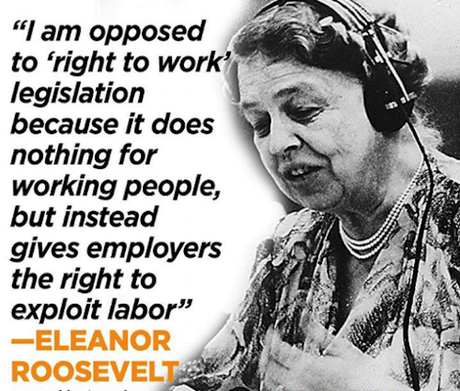
One of the biggest lies that corporations tell Americans is that labor unions interfere with a worker's "right to work". As Eleanor Roosevelt told us, that is not true. It just allows corporations (and other businesses) to keep wages low and workplaces dangerous. It let's employers exploit their workers.
Here, from ex-Labor Secretary Robert Reich, are other lies that corporations tell about unions. Don't believe them.
Wealthy corporations and their enablers have spread 5 big lies about unions in order to stop workers from organizing and to protect their own bottom-lines. Know the truth and spread the truth. Lie #1: Labor unions are bad for workers. Wrong. Unions are good for all workers – even those who are not unionized. In the mid-1950s, when a third of all workers in the United States were unionized, wages grew in tandem with the economy. That’s because workers across America – even those who were not unionized – had significant power to demand and get better wages, hours, benefits, and working conditions. Since then, as union membership has declined, the middle class has shrunk as well. Lie #2: Unions hurt the economy. Wrong again. When workers are unionized they can negotiate better wages, which in turn spreads the economic gains more evenly and strengthens the middle class. This creates a virtuous cycle: Wages increase, workers have more to spend in their communities, businesses thrive, and the economy grows. Since the the 1970s, the decline in unionization accounts for one-third of the increase in income inequality. Without unions, wealth becomes concentrated at the top and the gains don’t trickle down to workers. Lie #3: Labor unions are as powerful as big business. Now way. Labor union membership in 2018 accounted for 10.5 percent of the American workforce, while large corporations account for almost three-quarters of the entire American economy. And when it comes to political power, it’s big business and small labor. In the 2018 midterms, labor unions contributed less than 70 million dollars to parties and candidates, while big corporations and their political action committees contributed 1.6 billion dollars. This enormous gulf between business and labor is a huge problem. It explains why most economic gains have been going to executives and shareholders rather than workers. But this doesn’t have to be the case. Lie #4: Most unionized workers are in industries like steel and auto manufacturing. Untrue. Although industrial unions are still vitally important to workers, the largest part of the unionized workforce is workers in the professional and service sectors – retail, restaurant, hotel, hospital, teachers–which comprise 59% of all workers represented by a union. And these workers benefit from being in a union. In 2018, unionized service workers earned a median wage of 802 dollars a week. Non-unionized service workers made on average, $261 less. That’s almost a third less. Lie #5: Most unionized workers are white, male, and middle-aged. Some unionized workers are, of course, but most newly-unionized workers are not. They’re women, they’re young, and a growing portion are black and brown. In fact, it’s through the power of unions that people who had been historically marginalized in the American economy because of their race, ethnicity, or gender are now gaining economic ground. In 2018, women who were in unions earned 21 percent more than non-unionized women. And African-Americans who were unionized earned nearly 20 percent more than African-Americans who were non-unionized. Don’t believe the corporate lies. Today’s unions are growing, expanding, and boosting the wages and economic prospects of those who need them most. They’re good for workers and good for America.

